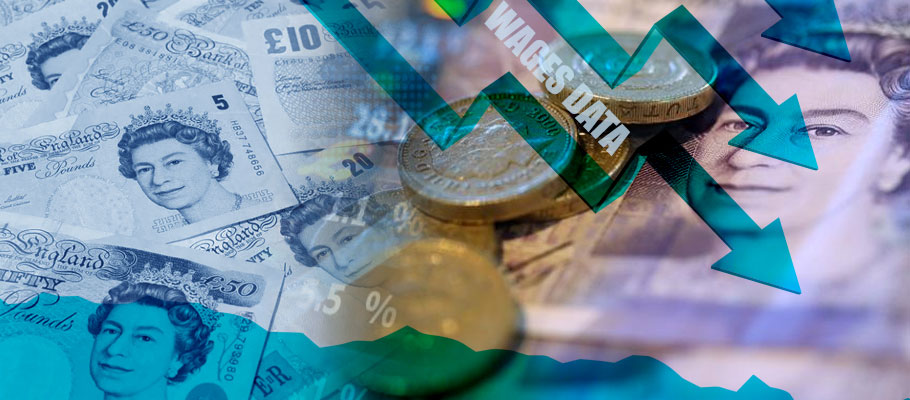
Published: March 13th, 2024
Pound Sterling started the week softer following publication of a UK job market survey by KPMG that confirmed a slowdown in wage increases had become bedded-in.
The survey revealed that the rate of salary inflation for permanent job placements had sunk to a three-year low. An index of permanent staff salaries dropped to 55.1 in February from 55.7 in January. For comparison, the index averaged 60.0 from 2015-2020.
The news sent the Pound to Euro exchange rate down from 1.1749 to 1.1729 as GBP shed some gains after ending the previous week on a strong footing.
Speaking to Bloomberg about the report, Rod Woodhouse, UK Lead Economist at Pantheon Macroeconomics, said the KPMG figures are highly credible given that its survey methodology has a 25-year track record of capturing shifts in wage growth. ‘The latest survey results suggest that BoE policymakers need to cut interest rates soon.’
While Sterling may have settled back naturally after experiencing a late advance last week, the KPMG survey confirmed the official ONS wage report, which also showed that UK wage increases had cooled significantly, opening the door for Threadneedle Street to cut interest rates in the coming months.
Given the back-to-back findings, forex traders began de-risking GBP positions. The Pound to Dollar exchange rate fell back on Monday to 1.2840 after reaching a seven-month high of 1.2893 last Friday.
The survey did note some increases in starting pay rates as employers reacted to rising cost of living and competition for top candidates. However, the rate of salary inflation was the slowest tracked in over three years.
In March of last year, GBP was beating back an advance by the US Dollar as American bond yields fell and forex traders scaled back expectations for future Fed rate hikes.
In the aftermath of the Silicon Valley Bank (SVB) collapse, the Greenback fell sharply when US bond yields fell faster than other markets. GBP was an early beneficiary, pushing higher on Monday 13th March as the week’s session got underway.
SVB's collapse has sent shockwaves through the global banking system. After losses on its bond-heavy investment portfolio it went on the hunt for fresh funding. American and British regulators sprang into action to protect SVB depositors, with Westminster shepherding the sale of SVB's UK assets to HSBC.
Ahead of the bank's fall into distress, the yield on two-year American government bonds rocketed to levels last seen in 2007. The sudden rise happened on trader expectations that the Fed will raise interest rates by 50 basis points next week. Bond yields then fell so quickly that markets now see a rate hike of 25 basis-points as more likely. The Dollar was hammered as a result.
The GBP/USD exchange rate rose by one percent to 1.2149. The EUR/USD exchange rose 0.80% to reach 1.0735.
The Greenback's losses were only been exacerbated by news that US lender Signature Bank had also collapsed after a sudden run, hardening investor perceptions that the pace of interest rate hikes by the Federal Reserve are altering how well the American financial system functions.
‘The failure of these banks can be traced back to rapidly rising interest rates and resulting yields, both directly driven by Fed monetary policy,’ said a report from Barclays FX and Commodity Research unit.
We know now that the damage was limited to lenders with outsized exposure to the tech and crypto sectors, but traders were betting at the time that the Fed would try and avoid further spreading of systemic stress.
The dollar extended declines in Asia on Tuesday, 14th March as traders continued to price in the impact of the SVB and Signature Bank collapses. Barclays said investors are now looking at the subsequent announcements by the Federal Reserve and Federal Depositors Insurance Corporation (FDIC) that other US banks would have access to a new lending facility to stop contagion from spreading.
‘Markets are witnessing this week the biggest three-day collapse in two-year US bond yields since 1987's Black Monday,’ Barclays added.
In March 2022 a rallying greenback hammered most G10 majors including the Euro and Yen. Barclay's FX strategy unit wrote at the time that the dollar's core drivers were ‘easy enough to see’.
‘You have a hawkish Fed mixed with a waning global risk appetite. Meanwhile the Eurozone is grappling with a situation that look like stagflation, while Chinese economic lockdowns sparked by the latest Covid outbreak look set to drag growth expectations down.’
Barclays said GBP/USD rate losses seen at the time were a reflection of the widening policy gap between the Fed and Bank of England (BoE). Monetary policy, its impact on American government bond yields and the relative advantage these bestowed the greenback were all on focus as the Federal Reserve readied markets for new policy decisions.
The Fed was widely expected to raise its interest rate by 50 basis points, as Chairman Jerome Powell essentially said previously that this would be considered at the April 2022 meeting.
‘When we decide on timings, we're mindful of the wider financial and economic context,’ Powell said at the Fed's monthly press conference in April 2022. ‘We will use the tools at our disposal to support financial and economic stability.’
‘We always want to support growth while sustaining financial stability. We also want to avoid bringing more uncertainty to an already uncertain situation.’
The dollar's gains and losses for other currencies combined to create an inflationary mess that risked pushing other G10 central banks to raise their respective interest rates earlier than they might have otherwise.
An analyst note from the FX strategy unit at BMO Capital Markets said at the time that remarks from both the BoE and ECB confirmed that a weak Euro had become a worry for Frankfurt.